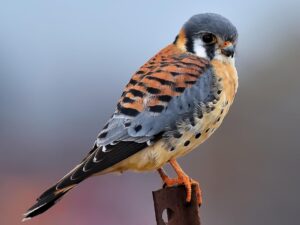By Hilary Turner
Have you ever struggled to identify a small hawk hunting your bird feeders, a distant raptor in flight, or even a perched raptor up close? You are not alone; raptor identification is notoriously difficult, making them some of the most frequently misidentified birds, even by expert birders! Join JHWF and Teton Raptor Center for a seminar on raptor identification and ecology, but first, here is a primer on the diurnal raptors of the GYE!
Raptors are carnivorous birds that eat small mammals, other birds, and insects. Often, their ecology and behavior can offer clues to their identification. There are three main groups of diurnal raptors: Accipiters, Buteos, and falcons. There are also Bald and Golden Eagles, Northern Harrier, and Osprey.
Accipiters are forest hawks. They have broad wings and long tails which assist them with maneuvering through densely wooded areas as they pursue prey. Three species are present in the GYE – the Sharp-shinned and Cooper’s Hawks and the Northern Goshawk. Sharp-shinned and Cooper’s Hawks are among the most misidentified North American birds. They have extremely similar plumage characteristics, but with a few helpful tips and some field experience, birders can start to confidently identify them. Adult goshawks have grayer coloration overall, with a bold white eyebrow, but juveniles can be confused with juvenile Cooper’s Hawks.

American Kestrel by Michael J.D.
Buteos are the open land hawks. They are often seen soaring high over an open landscape, where they spot prey with excellent vision. They have broad wings and shorter tails which assist them in taking advantage of thermal lift over the open landscapes they inhabit. In the winter, our most common Buteo is the Rough-legged Hawk, but there are also a small number of Red-tailed Hawks that overwinter in the GYE. In summer, Red-tailed Hawks become more common, as well as Swainson’s Hawks, which return to Jackson in the spring from their long-distance migration to wintering grounds on the pampas of Argentina and neighboring countries in South America. Ferruginous Hawks are most frequently detected during migration.
Falcons are aerial predators, built for speed with their sickle-shaped wings and long tails. Merlins are small falcons, most frequently detected during spring and fall migration in Jackson and the Teton Valley. They are ferocious predators that frequently take prey like doves and pigeons, which are approximately equal to their size. Prairie Falcons are larger falcons that breed in rocky cliffs overlooking open areas. My favorite place to observe Prairie Falcons near Jackson is by Miller Butte. Peregrine Falcons are also cliff nesters, but more typically in canyons such as those present in GTNP and some areas on the Bridger Teton NF. American Kestrels are dainty, but colorful, falcons that depend on small mammals and insects and nest in cavities.
The Northern Harrier can often be found coursing low over open vegetation, such as marshlands or agricultural fields. Their distinctive hunting techniques are diagnostic, as well as the male’s striking gray and white plumage. The Osprey nearly always associated with some kind of water. They mostly eat fish, but I have also seen Osprey carrying snakes they captured in the water. Bald and Golden Eagles are iconic birds, our largest raptors. Young Bald Eagles are frequently mistaken for Golden Eagles, but slight differences in plumage characteristics and habitat can be helpful.
Tune into our Raptor ID seminar on March 29 at 6:00PM to learn from Teton Raptor Center’s Meghan Warren about raptor identification and ecology that will help you to Nature Map raptors with more confidence and accuracy! (Hint: the April Nature Mapping Challenge might have to do with Nature Mapping raptors!) Email hilary@jhwildlife.org to sign up for the seminar.
